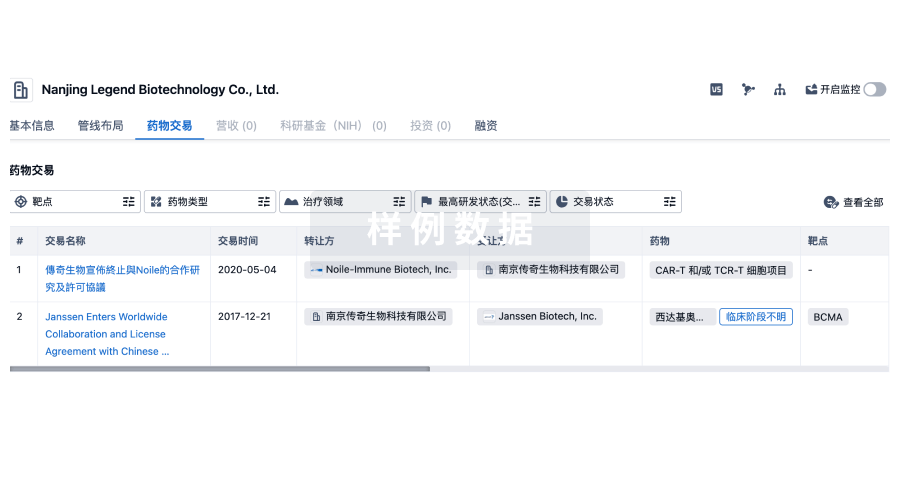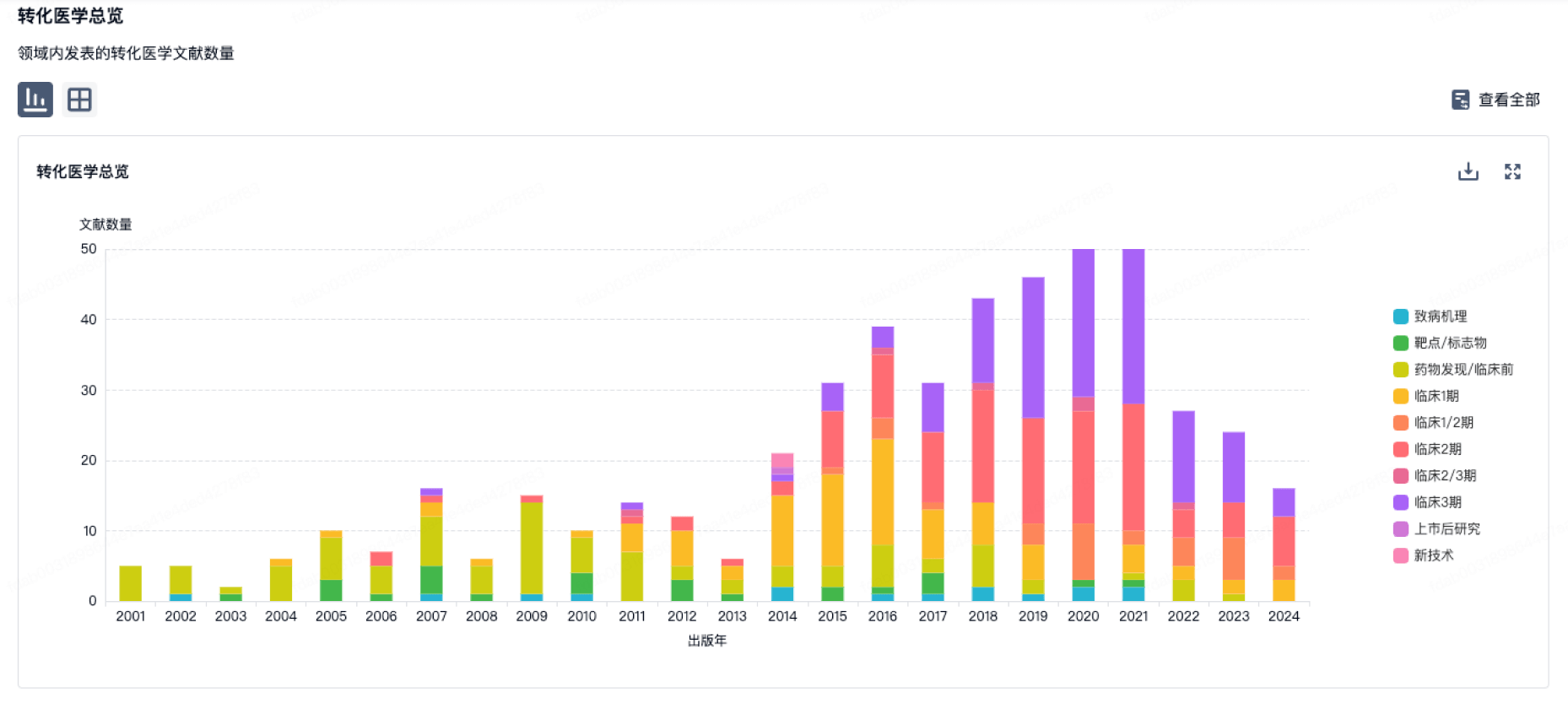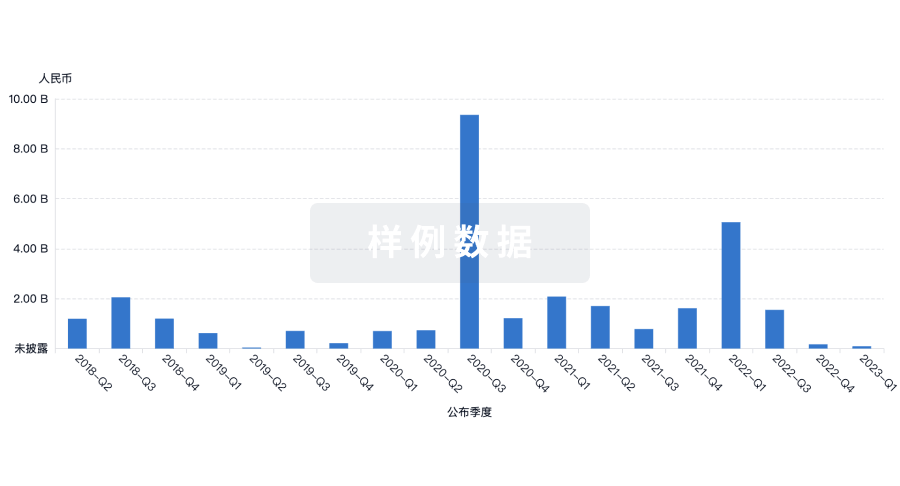预约演示
更新于:2025-11-07

ABL Bio, Inc.
更新于:2025-11-07
概览
标签
肿瘤
血液及淋巴系统疾病
神经系统疾病
双特异性抗体
抗体
ADC
疾病领域得分
一眼洞穿机构专注的疾病领域
暂无数据
技术平台
公司药物应用最多的技术
暂无数据
靶点
公司最常开发的靶点
暂无数据
| 排名前五的药物类型 | 数量 |
|---|---|
| 双特异性抗体 | 11 |
| 抗体 | 5 |
| ADC | 5 |
| 未知 | 1 |
| 双特异性T细胞结合器 | 1 |
关联
23
项与 ABL Bio, Inc. 相关的药物作用机制 DLL4抑制剂 [+1] |
原研机构 |
最高研发阶段临床2/3期 |
首次获批国家/地区- |
首次获批日期- |
作用机制 4-1BB激动剂 [+1] |
在研机构 |
原研机构 |
非在研适应症- |
最高研发阶段临床1/2期 |
首次获批国家/地区- |
首次获批日期- |
作用机制 4-1BB激动剂 [+3] |
在研机构 |
原研机构 |
非在研适应症- |
最高研发阶段临床1/2期 |
首次获批国家/地区- |
首次获批日期- |
7
项与 ABL Bio, Inc. 相关的临床试验NCT07158918
A Multicenter, Open-label, Phase 1b/2 Trial of ABL103, a Bispecific Antibody of B7-H4 and 4-1BB, in Combination With Pembrolizumab With/Without Taxane in Subjects With Selected, Progressive, Locally Advanced (Unresectable) or Metastatic Solid Tumors
This study is to assess the safety and antitumor activity of ABL103 plus pembrolizumab, with or without taxane, in advanced or metastatic solid tumors.
开始日期2025-08-06 |
申办/合作机构  ABL Bio, Inc. ABL Bio, Inc. [+1] |
NCT06126666
A Phase 1 Dose Escalation and Expansion Study of ABL103, a Bispecific Antibody of 4-1BB and B7-H4, as a Single Agent in Subjects With Any Progressive Locally Advanced or Metastatic Solid Tumors
This is a first-in-human Phase 1, single-arm, open-label, multicenter, multiple-dose, dose-escalation study of ABL103 to evaluate the safety, tolerability, MTD (maximum tolerated dose) and/or RP2D (recommended phase 2 dose), pharmacokinetics, immunogenicity, preliminary antitumor activity of ABL103 in subjects with any progressive locally advanced(unresectable) or metastatic solid tumor who are relapsed or refractory following the last line of treatment and have no available standard of care option. This study includes 2 parts: a dose-escalation part and tumor-expansion part
开始日期2023-11-07 |
申办/合作机构 |
NCT05756920
A Phase 1 Randomized, A Phase 1 Randomized, Placebo Controlled, Double Blind, Two Part, Single- and Multiple-Ascending-Dose Trial to Evaluate the Safety, Tolerability, Pharmacokinetics and Pharmacodynamics of Intravenously Administered ABL301 in Healthy Adult Participants
This is a Phase 1, FIH, randomized, double-blind, placebo-controlled study designed to assess the safety, tolerability, PK and PD after SAD and MAD in healthy adult participants.
开始日期2022-12-31 |
申办/合作机构 |
100 项与 ABL Bio, Inc. 相关的临床结果
登录后查看更多信息
0 项与 ABL Bio, Inc. 相关的专利(医药)
登录后查看更多信息
17
项与 ABL Bio, Inc. 相关的文献(医药)2025-09-01·New Biotechnology
Differential polyamine metabolism in CHO cell lines: Insights into cell growth and antibody quality
Article
作者: You, Weon-Kyoo ; Senthilkumar, Deepikka ; Hong, Jong Kwang ; Ganapathy, Tejaswini ; Jeon, Jae Hong ; Lakshmanan, Meiyappan ; Kang, Da Eun
Chinese hamster ovary (CHO) cell lines are widely utilized host cell lines in cell culture bioprocessing. Although they originated from a common ancestor, accumulated genetic mutations have led to significant heterogeneity in their behavior under specific conditions. This study investigates the cell line-specific impact of polyamine (PUT; putrescine) withdrawal on the growth, metabolism, and antibody production among three CHO clones derived from different parental cell lines: CHO-K1, CHO-S, and CHO-DG44. CHO-K1 cells strongly depended on external polyamines, showing a 77 % reduction in viable cell density and an 88 % decrease in growth rate under PUT depletion, although their culture longevity was extended. In contrast, CHO-S and CHO-DG44 cells demonstrated greater resilience, with CHO-DG44 experiencing only a 25 % reduction in cell density. PUT deprivation also impacted antibody production across all cell lines, with CHO-K1 displaying the lowest yield, antibody purity and altered charge heterogeneity. Notably, PUT depletion led to increased galactosylation of antibodies, suggesting that modulating PUT levels in the media could be used as a strategy to tailor the quality of therapeutic antibodies. These findings, together, provide valuable insights in the design of cell line-specific media, thereby optimizing both bioprocess efficiency and product quality in biopharmaceutical production.
2025-02-01·Journal for ImmunoTherapy of Cancer
Fc-competent TIGITx4-1BB bispecific antibody exerts potent long-lasting antitumor activity by potentiating CD8+ T cell activity and Fcγ receptor-mediated modulation of the tumor microenvironment
Article
作者: Sung, Byungje ; Lee, Sang Hoon ; Youn, Hyunseong ; Lee, Yangsoon ; Won, Jonghwa ; Park, Kyeong-Su ; Seo, Arim ; Park, Yelim ; Kim, Sora ; Son, Wonjun
Background:
TIGIT was identified as a target immune checkpoint for overcoming resistance to PD-(L)1-blocking antibodies. However, the clinical efficacies of TIGIT antibodies were moderate in monotherapy and mixed in combination with PD-(L)1 antibodies. 4-1BB, a strong inducible costimulatory receptor, is another attractive target in antitumor therapeutics. This study investigated whether ABL112, an Fc-competent bispecific antibody targeting TIGIT and 4-1BB (TIGITx4-1BB), would enhance antitumor activity via Fcγ receptor (FcγR)-mediated macrophage activation and antibody-dependent cell-mediated functions.
Methods:
TIGIT-dependent 4-1BB activation and TIGIT-blocking activity were assessed using reporter Jurkat T cell lines expressing 4-1BB and TIGIT, respectively. In vivo antitumor activity was confirmed in h4-1BB knock-in mice. The main immune cell subsets associated with the antitumor activity of ABL112 were identified using antibodies for depleting specific immune cell subtypes or FcγR-blocking antibodies. The effects of a combined pembrolizumab or atezolizumab treatment with ABL112 were assessed in two mouse models with different genetic backgrounds. Statistical analysis was performed using one-way or two-way analysis of variance (ANOVA) with Dunnett’s multiple-comparison test or one-way ANOVA with Fisher’s multiple-comparison test.
Results:
ABL112 restored T cell activity by blocking TIGIT–CD155 interactions, based on a TIGIT blockade reporter assay. ABL112, an Fc-competent TIGITx4-1BB bispecific antibody, showed strong FcγRI-dependent 4-1BB activation along with TIGIT-dependent 4-1BB activation. In H22 tumor models expressing high levels of endogenous CD155, both ABL112 and parent TIGIT single-domain Ab showed potent tumor-suppressive activity; however, only ABL112 exerted long-lasting antitumor activity. ABL112 induced a marked decrease in Treg numbers, while augmenting the absolute number of CD8+ T cells and proportion of CD226+ CD8+ T cells. The expressions of CXCL10, CXCL11, IFN-γ, and TNF-α increased, indicating myeloid cell activation and potential modification of the tumor microenvironment to an inflammatory phenotype. ABL112 not only showed outstanding antitumor activity as a monotherapy, but also showed synergistic effects with PD-(L)1 mAb compared with the combined TIGIT–PD-(L)1 mAb treatments.
Conclusions:
Through multiple mechanisms of action, ABL112 exerted potent tumor-killing activity and immune memory response alone or in combination with anti-PD-(L)1 therapies, representing a promising new cancer treatment strategy.
2024-09-13·CLINICAL CANCER RESEARCH
Anti–4-1BB×PDL1 Bispecific Antibody Reinvigorates Tumor-Specific Exhausted CD8+ T Cells and Enhances the Efficacy of Anti-PD1 Blockade
Article
作者: Chung, Youseung ; Jeon, Jaehyoung ; Kim, Hyunjoo ; Son, Woo-Chan ; Kim, Youngkwang ; Jeon, Seung Hyuck ; Shin, Eui-Cheol ; Lee, Jung-Yun ; You, Gihoon ; Han, Dai Hoon ; Park, Junsik ; Park, Su-Hyung ; Jung, Jaeho ; Park, Kyungjin ; Jeong, Da Som
Abstract:
Purpose::
To overcome the limited efficacy of immune checkpoint blockade, there is a need to find novel cancer immunotherapeutic strategies for the optimal treatment of cancer. The novel anti–4-1BB×PDL1 bispecific antibody—ABL503 (also known as TJ-L14B)—was designed to simultaneously target PDL1 and 4-1BB and demonstrated strong antitumor T-cell responses without considerable toxicity. In this study, we investigated the mechanisms by which the combination of ABL503 and anti-PD1 blockade affected the reinvigoration of exhausted tumor-infiltrating CD8+ T cells (CD8+ TIL) and antitumor efficacy.
Experimental Design::
Single-cell suspensions of hepatocellular carcinoma and ovarian cancer tissues from treatment-naïve patients were used for immunophenotyping of CD8+ TILs and in vitro functional assays. Humanized hPD1/hPDL1/h4-1BB triple–knock-in mice were used to evaluate the effects of ABL503 and anti-PD1 blockade in vivo.
Results::
We observed that ABL503 successfully restored the functions of 4-1BB+ exhausted CD8+ TILs, which were enriched for tumor-specific T cells but unresponsive to anti-PD1 blockade. Importantly, compared with anti-PD1 blockade alone, the combination of ABL503 and anti-PD1 blockade further enhanced the functional restoration of human CD8+ TILs in vitro. Consistently, the combination of ABL503 with anti-PD1 in vivo significantly alleviated tumor growth and induced enhanced infiltration and activation of CD8+ TILs.
Conclusions::
ABL503, a PDL1 and 4-1BB dual-targeting bispecific antibody, elicits pronounced additive tumor growth inhibition, with increased infiltration and functionality of exhausted CD8+ T cells, which in turn enhances the anticancer effects of anti-PD1 blockade. These promising findings suggest that ABL503 (TJ-L14B) in combination with PD1 inhibitors will likely further enhance therapeutic benefit in clinical trials.See related commentary by Molero-Glez et al., p. 3971
187
项与 ABL Bio, Inc. 相关的新闻(医药)2025-11-04
PALO ALTO, Calif.--(BUSINESS WIRE)--NEOK Bio, Inc., a biotechnology company focused on the development of novel antibody drug conjugates (ADCs) for improving outcomes for cancer patients, announced that it has emerged from stealth mode with $75 million in Series A financing. The company’s principal investor is ABL Bio, Inc., a leading Korean biotech company and a proven leader in antibody engineering. The funding will be used to advance two bispecific ADC programs into the clinic. The company aims to be a leading bispecific ADC company in the U.S.
Leveraging ABL’s innovative ADC platform technology, NEOK is building a pipeline of bispecific ADCs by pursuing validated targets, while balancing high expression, selectivity, and target-related safety signals. NEOK utilizes a proprietary, linker-payload technology (SYNtecan E™) that enables ADC generation with strong linker stability and superior biophysical properties. The company aims to overcome the efficacy and safety limitations of conventional ADCs through its bispecific approach which targets unique pairs of cancer targets.
“ADCs are a proven modality in treating select cancers, but historically have had limitations related to stability, selectivity, and therapeutic window. We believe our dual-targeting strategy has the potential to overcome drug resistance, target a wider range of tumors, increase internalization rates and cell killing, and improve the safety profile of ADCs by increasing selectivity and reducing off-tumor toxicity,” said Mayank Gandhi, Chief Executive Officer of NEOK Bio. “The financing is a critical step in our journey to a clinical-stage company and enables the execution of a robust and efficient clinical development plan for our bispecific ADCs.”
“Our investment in the formation of NEOK Bio underscores our commitment to deliver transformative therapeutic innovation to the dynamic and growing ADC landscape,” said ABL Bio CEO Dr. Sang Hoon Lee. “We are excited to support an outstanding and experienced NEOK team as they aim to fulfill the significant untapped potential of bispecific ADCs to improve the lives of people with cancer.”
The financing will support the initiation of clinical studies for NEOK’s two lead ADC candidates, which target proteins that are broadly expressed in multiple tumor types with significant unmet needs. They include NEOK001 (previously ABL206), a bispecific ADC targeting ROR1 and B7-H3, and NEOK002 (previously ABL209), a bispecific ADC targeting EGFR and MUC1 proteins. Both assets have the potential to demonstrate enhanced efficacy and safety over monovalent ADCs in large patient populations across thoracic, gastrointestinal, and gynecological cancers.
NEOK plans to file an Investigational New Drug (IND) application for both programs by early 2026 and initiate Phase 1 clinical trials in mid-2026 in the U.S. First data readouts from both programs are expected in 2027.
About NEOK Bio
NEOK Bio, Inc. is a biotechnology company focused on the development of novel antibody drug conjugates (ADCs) that are designed to improve outcomes for cancer patients. NEOK is rapidly advancing bispecific ADCs which represent a cutting-edge advancement, leveraging bispecific antibodies that target two complimentary antigens, potentially improving safety while enhancing the efficacy of ADCs in a wider range of tumors. Backed by ABL Bio, Inc., a proven leader in antibody engineering, NEOK plans to initiate clinical studies for its two lead bispecific ADC candidates in solid tumor indications in mid-2026. For additional information, visit www.neokbio.com.
抗体药物偶联物
2025-11-04
ABL Bio, a multi-partnered South Korean biotech, is backing a new Palo Alto, CA-based startup to carry forward two antibody-drug conjugates.
NEOK Bio emerged on Tuesday with a $75 million Series A, with ABL Bio as its “principal investor.” It plans to advance two ADCs into the clinic in the US around the middle of 2026 and gather initial clinical data in 2027.
The experimental bispecific ADCs are NEOK001 (ABL206) and NEOK002 (ABL209). The first goes after ROR1 and B7-H3, and the second targets EGFR and MUC1 proteins. Both are expected to be tested across a variety of cancers, including thoracic, gastrointestinal and gynecological, the company said.
ADCs have been a hot modality for the past few years in cancer drug development, with the promise of delivering potent medicines with fewer side effects than traditional chemotherapy. Other startups in the space have recently raised megarounds, including
Tubulis’ $401 million Series C
.
“We believe our dual-targeting strategy has the potential to overcome drug resistance, target a wider range of tumors, increase internalization rates and cell killing, and improve the safety profile of ADCs by increasing selectivity and reducing off-tumor toxicity,” NEOK CEO Mayank Gandhi said in a press release.
ABL is partnered with
GSK
, Sanofi, I-Mab (
now NovaBridge Biosciences
) and others.
抗体药物偶联物
2025-11-04
Backed by Korean biotech ABL Bio, NEOK Bio emerged from stealth on Tuesday with a $75-million series A to advance a pair of bispecific antibody-drug conjugates (ADCs) for thoracic, gastrointestinal and gynaecological cancers. Designed with ABL's linker-payload technology, the assets are intended to have improved stability and "superior biophysical properties." By targeting two cancer markers, NEOK believes its experimental treatments can offer safer, more efficacious treatments than currently approved ADCs. "ADCs…historically have had limitations related to stability, selectivity, and therapeutic window," said NEOK CEO Mayank Gandhi in a company release. "We believe our dual-targeting strategy has the potential to overcome drug resistance, target a wider range of tumours, increase internalisation rates and cell killing, and improve the safety profile of ADCs by increasing selectivity and reducing off-tumour toxicity." The startup's bispecific ADC pipeline includes NEOK001 (previously ABL206), which targets ROR1 and B7-H3, and NEOK002 (previously ABL209), directed against both EGFR and MUC1 proteins. The assets were transferred from ABL, which is a majority shareholder in NEOK.NEOK is aiming to submit IND applications to the FDA in early 2026, and start Phase I trials for both programmes in mid-2026. Initial data could come as soon as 2027.
抗体药物偶联物
100 项与 ABL Bio, Inc. 相关的药物交易
登录后查看更多信息
100 项与 ABL Bio, Inc. 相关的转化医学
登录后查看更多信息
组织架构
使用我们的机构树数据加速您的研究。
登录
或

管线布局
2025年11月08日管线快照
管线布局中药物为当前组织机构及其子机构作为药物机构进行统计,早期临床1期并入临床1期,临床1/2期并入临床2期,临床2/3期并入临床3期
药物发现
3
10
临床前
临床1期
8
1
临床2期
临床3期
1
21
其他
登录后查看更多信息
当前项目
| 药物(靶点) | 适应症 | 全球最高研发状态 |
|---|---|---|
ABL-103 ( 4-1BB x B7-H4 ) | 局部晚期恶性实体瘤 更多 | 临床1/2期 |
ABL-301 ( IGF-1R x α-synuclein ) | 帕金森病 更多 | 临床1期 |
Ragistomig ( 4-1BB x PDL1 ) | 晚期恶性实体瘤 更多 | 临床1期 |
ABL-501 ( LAG3 x PDL1 ) | 晚期恶性实体瘤 更多 | 临床1期 |
LCB-71 ( ROR1 ) | 血液肿瘤 更多 | 临床1期 |
登录后查看更多信息
药物交易
使用我们的药物交易数据加速您的研究。
登录
或

转化医学
使用我们的转化医学数据加速您的研究。
登录
或

营收
使用 Synapse 探索超过 36 万个组织的财务状况。
登录
或

科研基金(NIH)
访问超过 200 万项资助和基金信息,以提升您的研究之旅。
登录
或

投资
深入了解从初创企业到成熟企业的最新公司投资动态。
登录
或

融资
发掘融资趋势以验证和推进您的投资机会。
登录
或

生物医药百科问答
全新生物医药AI Agent 覆盖科研全链路,让突破性发现快人一步
立即开始免费试用!
智慧芽新药情报库是智慧芽专为生命科学人士构建的基于AI的创新药情报平台,助您全方位提升您的研发与决策效率。
立即开始数据试用!
智慧芽新药库数据也通过智慧芽数据服务平台,以API或者数据包形式对外开放,助您更加充分利用智慧芽新药情报信息。
生物序列数据库
生物药研发创新
免费使用
化学结构数据库
小分子化药研发创新
免费使用
